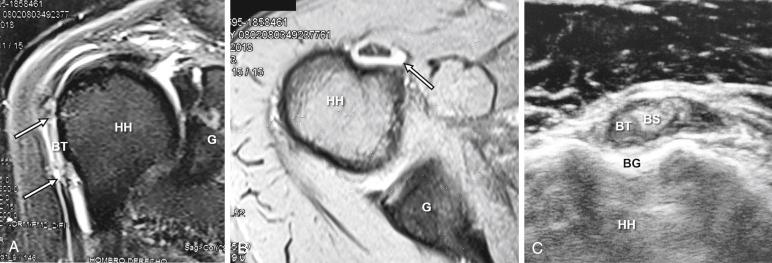Physical Address
304 North Cardinal St.
Dorchester Center, MA 02124
The long head of the biceps tendon (LHBT) is a frequent source of shoulder pain due to tendon instability or degenerative changes. Tendon instability can be located on the superior labrum anterior-posterior (SLAP) insertion site or at the bicipital groove. Details of SLAP repair are depicted in a different chapter of this book. In patients older than 40 years of age, current research demonstrates that biceps tenodesis outperforms SLAP repair.
In the presence of tendon instability at the bicipital groove, the outcome following biceps pulley reconstruction is often unpredictable, therefore adjunctive tenodesis remains essential. LHBT degenerative changes are common findings and often require a surgical approach.
Even though biceps tenotomy constitutes a valuable option for the elderly patient, young and/or athletic patients with biceps pathology typically require tendon fixation at the proximal humerus or at the adjacent soft tissue structures. Surgeons, even experts, often face a dilemma when choosing the most suitable place for biceps tendon fixation and how to do it right. The goal of this chapter is to describe the advantages and drawbacks of the current most popular techniques for biceps tenodesis.
The LHBT fixation site can be either: 1) proximal, close to the glenohumeral joint, or 2) suprapectoral, at the level of the bicipital groove but above the falciform ligament and pectoralis major, or 3) or subpectoral, distal to the pectoralis major. The most common ways to fix the LHBT are: 1) to stitch the tendon to the cortical bone with suture anchors, 2) to attach the tendon with sutures to the soft tissue structures nearby, or 3) to steer the tendon inside the bone socket and lock it with interference screws. These three techniques will be further detailed in this section.
Patients usually complain about pain above the shoulder level during sports or working activities. The pain is located mainly anterior, but lateral or posterior irradiation is not uncommon. Physical signs and examination maneuvers are described in Box 46.1 .
One finger pain at the bicipital groove about 7 cm below the acromion level with the arm in 10 degrees of internal rotation.
Yergason Test: Pain with resisted forearm supination.
Speed Test: Pain with resisted forward flexion in 90 degrees, the elbow fully extended and the forearm supinated.
Active Compression Test. O’Brien Sign: The arm is 90 degrees of forward flexion, adduction 15 degrees, full internal rotation (thumb down) with a downward force from the examiner.
Abbot and Sanders. Pain and snap at the bicipital groove during passive arm motion back and forth from abduction-external rotation to adduction-internal rotation.
Bear Hug and Upper Cut Test. Active and resisted motion with the elbow flexed in the contralateral shoulder or anterior direction.
Contrasted magnetic resonance imaging (MRI) is critical to evaluate SLAP lesions, whereas dynamic ultrasound is best suited for the assessment of LHBT instability at the groove. After a relatively short learning curve, and with the help of the new light and mobile echography devices, the surgeon can easily scan the LHBT and evaluate its mobility in and outside its groove. Tissue quality and increased fluid around the tendon can also be detected by the ultrasound examination.
Noncontrasted MRI is key to defining surrounding structures such as subscapularis or supraspinatus tendons. Coronal and axial slices also delineate static tendon position and the amount of liquid at the bicipital sheath ( Fig. 46.1 ).

Become a Clinical Tree membership for Full access and enjoy Unlimited articles
If you are a member. Log in here